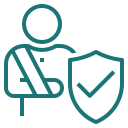"*" indicates required fields

Catching a taxi is something that many will do on a regular basis, while for others it is an occasional thing. But no matter how often you use taxis as a mode of transport, it is important to know what rights you have if you have been injured in an accident while a passenger in a taxi. After all, taking a taxi is placing your safety in someone else’s hands, so you want to know you will be protected if you are hurt.
Not counting Uber and other types of rideshare services, taxis make up a large portion of the Australian transport industry. The last count of taxis in Australia showed that there were 21,344 taxis Australia-wide with 408,400,000 passengers served that year. This is a large leap from when the first motorised taxi was introduced in Sydney in 1906, and while the ridesharing industry has definitely changed the monopoly taxis used to have over Australian commuters, they are still a popular and well-used method of transport.
So if you were travelling as a passenger in a taxi and the driver has been involved in an accident causing you injury – whether due to their driving or someone else’s – then you may be able to make a claim for compensation. Our compensation lawyers can help you commence your claim for compensation for the injuries sustained and possible loss of income as a result of your injury. All claims are run on a no win, no fee basis with no upfront costs.


Speak to our Brisbane based personal injury lawyers today about the claim process if you have been injured in a taxi accident. We can help you commence a personal injury claim to recover compensation for possible lost income, medical expenses, and pain and suffering associated with your accident.

As a passenger in a taxi you are covered for your injury and possible loss of income if your are involved in an accident on the road, even if the taxi driver was at fault. This is due to compulsory third party (CTP) insurance, which is an insurance scheme that covers you in the event an accident occurs while you are in a taxi. If you have suffered an injury as a passenger in a taxi, you may be able to claim against the at-fault driver, including of your own cab.
Example: Gina is taking a taxi home from the airport. The taxi driver picks her up and then as she is exiting the airport taxi parking area, the taxi is hit from behind by another cab, and Gina is shunted forward, colliding with the seat in front of her and breaking her nose. She has to take three weeks off work to recover and has to have reconstructive surgery. Gina would be able to make a claim against the other taxi driver’s CTP insurance, and the claim would cover lost income (both present and future), reasonable medical expenses, and any other relevant costs.
Morgan is taking a taxi to visit a friend when the taxi driver negligently reverses over her foot as she is stepping into the car. Morgan would be able to claim against the driver for the damage to her foot, loss of income and medical expenses associated with recovery.

Been in a taxi accident? Follow these steps to ensure you have all the information you need to make a claim for compensation:

In some cases, accidents happen when you are not wearing a seatbelt. In this case, any claim for compensation may result in a decrease of the overall amount paid to you due to contributory negligence.
Example: Rodney is coming home from a night out in the city with friends. He doesn’t put his seatbelt on as it’s only 10 minutes down the road and less focussed after a few drinks. As they are driving along, the taxi driver is negligent and does not pay attention, running up the back of a parked car.
Rodney is seriously injured as a result of the accident, and has a large period of time off work as he recovers, along with a significant amount of medical treatment. While Rodney would be successful in claiming against the taxi driver for failing to pay attention to the road, he would be found to have contributed to the severity of his injuries because he was not wearing a seatbelt. Due to this contributory negligence, the amount of compensation would be reduced by a percentage.

Compensation claims are calculated to try and return you to the position you were in - at least financially - before the accident happened. This means that if you lost money due to being off work, this will be included in the compensation calculation. Similarly, if you had to have surgery or stay in hospital, this will be included.
Compensation amounts vary, but one matter where the person injured suffered whiplash and trauma to the spine and pelvis, the plaintiff was awarded over $200,000. This was calculated looking at:
It is also worth noting that if you are using a taxi to travel to or from work, you may also be eligible to claim against WorkCover for workers compensation. We can assist you in identifying which insurance company is the relevant party for your claim and help you with the process.

When injured in a taxi accident, you generally have three years in which to commence a possible claim for compensation. There are certain circumstances when this is a longer (or shorter) time frame. Read more about time limits for personal injury claims in our guide.
It is understandable that the last thing you might want to do when you have suffered an injury is to make a claim for compensation. But it is vital that you start your claim before the time limits expire so that you are not barred from getting the compensation you may be eligible for.
That is where we can assist you. Our team of Brisbane accident lawyers can help you throughout the entire process of your claim and will be there for you at every stage to ensure you are supported and know where you stand.
If you are a taxi driver whose passenger suffered an injury as a result of your driving, you are protected under the CTP scheme which provides compensation for their injury. As road users, you are susceptible to fatigue and driver error which can contribute to accidents. But know that you are protected under insurance if your passenger is injured as a result of your driving.